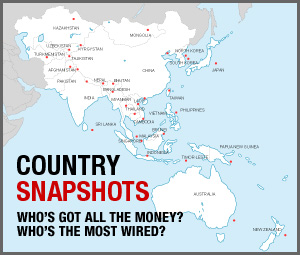Sun to set on US role in APAC?
 Image: Beverly & Pack
Image: Beverly & Pack
As all this was unfolding, US officials were also pushing back against prevailing assessments of US decline, and were moving to underscore the Bush administration’s carefully considered judgment that China’s rise actually was not having a substantial negative effect on US leadership in Asia. Bush administration officials had differed in private on how to view the implications of China’s rise in the Asia-Pacific, but they increasingly rallied around the public position first articulated in 2005 by now World Bank President Robert Zoellick, who suggested that the United States was best served by seeking to work with China and encourage it to behave as a ‘responsible’ stakeholder in the international system. This approach has continued under President Barack Obama.
But regardless of who is in the White House, there are four yardsticks that should be used to judge US strength and influence in Asia, now and in the future.
Security concerns
In most of the Asia-Pacific, governments are strong, viable and make the decisions that determine their direction in foreign affairs. Popular opinion and the media may influence government officials responsible for formulating policy toward the United States and others, but ultimately they make their own decisions. In general, the officials see their governments’ legitimacy and success resting on nation building and economic development, which require a stable and secure international environment. Unfortunately, the region is not particularly stable and most governments are, in private at least, wary of one another. As a result, they look to the United States to provide the security they need to pursue their goals in an appropriate environment. They also recognize that the US security role is extremely costly and involves great risk, including large-scale casualties if necessary. With this also comes recognition that neither a rising China nor any other Asian power or coalition of powers is able–or willing–to undertake even a fraction of these risks, costs and responsibilities.
Economic priorities
Nation building for most Asia-Pacific governments depends largely on export-oriented growth. Chinese officials recognize this, while officials in other countries recognize the rising importance of China in their trade. However, they all also recognize that foreign invested enterprises account for China’s trade, as does processing trade–both of which make Chinese and Asia-Pacific trade heavily dependent on exports to developed countries, particularly the United States.
In recent years, the United States has run a massive trade deficit with China, and a total trade deficit with Asia of more than $350 billion, all at a time when the US trade deficit stands at over $700 billion. Asia-Pacific government officials recognize that China, which runs a large overall trade surplus, and other regional trading partners are unwilling and unable to bear even a fraction of the cost of such large trade deficits.
Clearly, the 2008-2009 global economic crisis is having an enormous impact on trade and investment, prompting some Asian officials to talk about relying more on domestic consumption. But tangible progress toward this end seems slow, as they appear to be focusing on a revival of world trade that would restore as much as possible previous levels of export-oriented growth, including heavy reliance on the US market.
How cooperative China actually will be in working with the United States to deal with the various implications of the economic crisis also remains an open question, though the evidence appears on balance to show great care on the part of the Chinese administration to avoid pushing controversial policies that would further undermine international confidence in the existing economic system and thwart meaningful efforts at recovery. Indeed, the Chinese leadership appears to be prioritising stability in its continued adherence to international economic patterns, including the leading role of the US dollar, strong direct and indirect US influence on foreign investors in China, and the US market as a top priority for Chinese products.
Government Engagement and Asia-Pacific Contingency Planning
Generally speaking, the Bush administration managed to develop effective interactions with Asia’s leading powers. It’s rare for the United States to enjoy good relations with Japan and China at the same time, but the Bush administration carefully managed relations with both effectively. It’s also unprecedented for the United States to be the leading foreign power in South Asia and to sustain good relations with both India and Pakistan, but that has been the case since relatively early in the Bush administration. And it’s unprecedented for the United States to have healthy ties with Beijing and Taipei at the same time, but this also occurred during the Bush years and was strengthened with the election of Taiwan President Ma Ying-jeou in March 2008.










